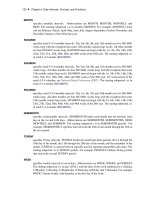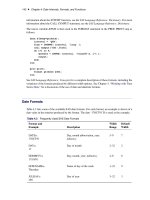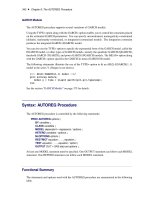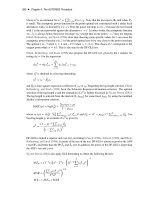SAS/ETS 9.22 User''''s Guide 15 pdf
Bạn đang xem bản rút gọn của tài liệu. Xem và tải ngay bản đầy đủ của tài liệu tại đây (213.9 KB, 10 trang )
132 ✦ Chapter 4: Date Intervals, Formats, and Functions
MONTH
specifies monthly intervals. Abbreviations are MONTH, MONTHS, MONTHLY, and
MON. The starting subperiod s is in months (MONTH). For example, MONTH2.2 inter-
vals are February–March, April–May, June–July, August–September, October–November, and
December–January of the following year.
R445MON
specifies retail 4-4-5 monthly intervals. The 3rd, 6th, 9th, and 12th months are five ISO 8601
weeks long with the exception that some
12
th months contain leap weeks. All other months
are four ISO 8601 weeks long. R445MON intervals begin with the
1
st,
5
th,
9
th,
14
th,
18
th,
22
nd,
27
th,
31
st,
35
th,
40
th,
44
th, and
48
th weeks of the ISO year. The starting subperiod s is
in retail 4-4-5 months (R445MON).
R454MON
specifies retail 4-5-4 monthly intervals. The
2
nd,
5
th,
8
th, and
11
th months are five ISO 8601
weeks long. All other months are four ISO 8601 weeks long with the exception that some
12
th months contain leap weeks. R454MON intervals begin with the
1
st,
5
th,
10
th,
14
th,
18
th,
23
rd,
27
th,
31
st,
36
th,
40
th,
44
th, and
49
th weeks of the ISO year. For a discussion of the
retail 4-5-4 calendar, see National Retail Federation (2007). The starting subperiod s is in
retail 4-5-4 months (R454MON).
R544MON
specifies retail 5-4-4 monthly intervals. The
1
st,
4
th,
7
th, and
10
th months are five ISO 8601
weeks long. All other months are four ISO 8601 weeks long with the exception that some
12
th months contain leap weeks. R544MON intervals begin with the
1
st,
6
th,
10
th,
14
th,
19
th,
23
rd,
27
th,
32
nd,
36
th,
40
th,
45
th, and
49
th weeks of the ISO year. The starting subperiod s is
in retail 5-4-4 months (R544MON).
SEMIMONTH
specifies semimonthly intervals. SEMIMONTH breaks each month into two periods, start-
ing on the
1
st and
16
th days. Abbreviations are SEMIMONTH, SEMIMONTHS, SEMI-
MONTHLY, and SEMIMON. The starting subperiod s is in SEMIMONTH periods. For
example, SEMIMONTH2.2 specifies intervals from the
16
th of one month through the
15
th of
the next month.
TENDAY
specifies 10-day intervals. TENDAY breaks the month into three periods, the
1
st through the
10
th day of the month, the
11
th through the
20
th day of the month, and the remainder of the
month. (TENDAY is a special interval typically used for reporting automobile sales data.) The
starting subperiod s is in TENDAY periods. For example, TENDAY4.2 defines 40-day periods
that start at the second TENDAY period.
WEEK
specifies weekly intervals of seven days. Abbreviations are WEEK, WEEKS, and WEEKLY.
The starting subperiod s is in days (DAY), with the days of the week numbered as 1=Sunday,
2=Monday, 3=Tuesday, 4=Wednesday, 5=Thursday, 6=Friday, and 7=Saturday. For example,
WEEK.7 means weekly with Saturday as the first day of the week.
Summary of Interval Types ✦ 133
WEEKV
specifies ISO 8601 weekly intervals of seven days. Each week starts on Monday. The starting
subperiod s is in days (DAY). Note that WEEKV differs from WEEK in that WEEKV.1 starts
on Monday, WEEKV.2 starts on Tuesday, and so forth.
WEEKDAY
WEEKDAYdW
WEEKDAYddW
WEEKDAYdddW
specifies daily intervals with weekend days included in the preceding weekday. Note that
for a five-day work week that starts on Monday, the appropriate interval is WEEKDAY5.2.
Abbreviations are WEEKDAY and WEEKDAYS. The starting subperiod s is in weekdays
(WEEKDAY).
The WEEKDAY interval is the same as DAY except that weekend days are absorbed into the
preceding weekday. Thus, there are five WEEKDAY intervals in a calendar week: Monday,
Tuesday, Wednesday, Thursday, and the three-day period Friday-Saturday-Sunday.
The default weekend days are Saturday and Sunday, but any one to six weekend days can be
listed after the WEEKDAY string and followed by a W. Weekend days are specified as ‘1’
for Sunday, ‘2’ for Monday, and so forth. For example, WEEKDAY67W specifies a Friday-
Saturday weekend. WEEKDAY1W specifies a six-day work week with a Sunday weekend.
WEEKDAY17W is the same as WEEKDAY.
DAY
specifies daily intervals. Abbreviations are DAY, DAYS, and DAILY. The starting subperiod s
is in days (DAY).
HOUR
specifies hourly intervals. Aliases are HOUR, DTHOUR, HOURS, DTHOURS, HOURLY,
DTHOURLY, HR, and DTHR. The starting subperiod s is in hours (HOUR).
MINUTE
specifies minute intervals. Aliases are MINUTE, DTMINUTE, MINUTES, DTMINUTES,
MIN, and DTMIN. The starting subperiod s is in minutes (MINUTE).
SECOND
specifies second intervals. Aliases are SECOND, DTSECOND, SECONDS, DTSECONDS,
SEC and DTSEC. The starting subperiod s is in seconds (SECOND).
134 ✦ Chapter 4: Date Intervals, Formats, and Functions
Examples of Interval Specifications
Table 4.1 shows examples of different kinds of interval specifications.
Table 4.1 Examples of Intervals
Name Description of Interval
YEAR Years that start in January
YEAR.10 Years that start in October
YEAR2.7 Biennial intervals that start in July of even years
YEAR2.19 Biennial intervals that start in July of odd years
YEAR4.11
Four-year intervals that start in November of leap years (frequency
of U.S. presidential elections)
YEAR4.35
Four-year intervals that start in November of even years between
leap years (frequency of U.S. midterm elections)
YEARV
Years that start on the Monday on or immediately preceding
January 4th
YEARV.2
Years that start on the Monday immediately following January 4th
R445MON
Months that start on the
1
st,
5
th,
9
th,
14
th,
18
th,
22
nd,
27
th,
31
st,
35th, 40th, 44th, and 48th Monday of the year. The 1st Monday is
the Monday on or immediately preceding January 4th
R445MON3
Three-month intervals that start on the
1
st,
14
th,
27
th, and
40
th
Monday of the year. This is equivalent to R445QTR
R445MON3.2
Three-month intervals that start on the
5
th,
18
th,
31
th, and
44
th
Monday of the year. This is equivalent to R445QTR.2
WEEK Weekly intervals that start on Sundays
WEEK2 Biweekly intervals that start on first Sundays
WEEK1.1 Same as WEEK
WEEK.2 Weekly intervals that start on Mondays
WEEK6.3 Six-week intervals that start on first Tuesdays
WEEK6.11 Six-week intervals that start on second Wednesdays
WEEKDAY
Daily with Friday-Saturday-Sunday counted as the same day (five-
day work week with a Saturday-Sunday weekend)
WEEKDAY17W
Same as WEEKDAY
WEEKDAY5.2
Five weekdays that start on Monday. If WEEKDAY data are accu-
mulated into weekly data, the interval of the accumulated data is
WEEKDAY5.2
WEEKDAY67W
Daily with Thursday-Friday-Saturday counted as the same day
(five-day work week with a Friday-Saturday weekend)
WEEKDAY1W
Daily with Saturday-Sunday counted as the same day (six-day work
week with a Sunday weekend)
WEEKDAY3.2
Three-weekday intervals (with Friday-Saturday-Sunday counted
as one weekday) with the cycle three-weekday periods aligned to
Monday, January 4, 1960
HOUR8.7
Eight-hour intervals that start at 6 a.m., 2 p.m., and 10 p.m. (might
be used for work shifts)
Custom Time Intervals ✦ 135
Custom Time Intervals
The standard time intervals described in the previous sections do not always fit the data. For example,
you might want to use fiscal months that begin on the 10th of each month, but the MONTH interval
begins on the 1st of each month. Or you might collect data hourly for a business that is closed
at night, but using the DTHOUR interval results in gaps in the data that can cause problems in
standard time series analysis. In another case, you might wish to calculate the number of business
days between dates, excluding holidays and weekends, but holidays are counted when you use the
INTCK function with the WEEKDAY interval. For more information about the INTCK function, see
“Interval Functions INTNX and INTCK” on page 97.
Time series can be analyzed using observation numbers as the identifying reference. However, it is
often desirable to maintain the time stamp for other types of modeling such as regression variables
based on time or reconciliation.
To address these issues, you can define custom intervals within a given SAS program. The use of
custom intervals requires the following two steps for each interval:
1
Associate a data set name with a custom interval name by using the INTERVALDS= system
option. For more information about the INTERVALDS= option, see the SAS Language Reference:
Dictionary. The following example associates the data set StoreHoursDS with the custom interval
StoreHours.
options intervalds=(StoreHours=StoreHoursDS);
2
Create a data set that describes the custom interval. The data set must contain a BEGIN variable.
It can also contain an END and a SEASON variable. It should contain a FORMAT statement for
the BEGIN variable that specifies a SAS date, SAS datetime, or numeric format that matches the
BEGIN variable data. If the END variable is present, it should also be included in the FORMAT
statement. A numeric format that is not a SAS date or SAS datetime format indicates that the
values are observation numbers. If the END variable is not present, then the implied value of END
at each observation is one less than the value of BEGIN at the next observation.
The span of the custom interval data set should include any dates or times that are necessary for
performing calculations on the time series, including backcasting, forecasting, and other operations
that might extend beyond the series (such as filters).
After the two preceding steps have been completed, the custom interval can be specified in SAS
procedures and functions where a standard time interval can be specified.
136 ✦ Chapter 4: Date Intervals, Formats, and Functions
The following DATA step creates the StoreHoursDS data set, which is appropriate for a business that
is open 9AM to 6PM Monday through Friday and Saturday 9AM to 1PM:
options intervalds=(StoreHours=StoreHoursDS);
data StoreHoursDS(keep=BEGIN END);
start = '01JAN2009'D;
stop = '31DEC2009'D;
do date = start to stop;
dow = WEEKDAY(date);
datetime=dhms(date,0,0,0);
if dow not in (1,7) then
do hour = 9 to 17;
begin=intnx('hour',datetime,hour,'b');
end=intnx('hour',datetime,hour,'e');
output;
end;
else if dow = 7 then
do hour = 9 to 12;
begin=intnx('hour',datetime,hour,'b');
end=intnx('hour',datetime,hour,'e');
output;
end;
end;
format BEGIN END DATETIME.;
run;
title 'Store Hours Custom Interval';
proc print data=StoreHoursDS(obs=18);
run;
The first 18 observations of the custom interval data set are shown in Figure 4.1.
Figure 4.1 Store Hours Custom Interval
Store Hours Custom Interval
Obs begin end
1 01JAN09:09:00:00 01JAN09:09:59:59
2 01JAN09:10:00:00 01JAN09:10:59:59
3 01JAN09:11:00:00 01JAN09:11:59:59
4 01JAN09:12:00:00 01JAN09:12:59:59
5 01JAN09:13:00:00 01JAN09:13:59:59
6 01JAN09:14:00:00 01JAN09:14:59:59
7 01JAN09:15:00:00 01JAN09:15:59:59
8 01JAN09:16:00:00 01JAN09:16:59:59
9 01JAN09:17:00:00 01JAN09:17:59:59
10 02JAN09:09:00:00 02JAN09:09:59:59
11 02JAN09:10:00:00 02JAN09:10:59:59
12 02JAN09:11:00:00 02JAN09:11:59:59
13 02JAN09:12:00:00 02JAN09:12:59:59
14 02JAN09:13:00:00 02JAN09:13:59:59
15 02JAN09:14:00:00 02JAN09:14:59:59
16 02JAN09:15:00:00 02JAN09:15:59:59
17 02JAN09:16:00:00 02JAN09:16:59:59
18 02JAN09:17:00:00 02JAN09:17:59:59
Custom Time Intervals ✦ 137
The following DATA step creates the FMDS data set to define a custom interval FiscalMonth, which
is appropriate for a business that uses fiscal months that start on the 10th of each month. The SAME
alignment option of the INTNX function specifies that the dates generated by the INTNX function are
the same day of the month as the date in the start variable. For more information about the INTNX
function, see “SAS Date, Time, and Datetime Functions” on page 147. The MONTH function
assigns the month of the BEGIN variable to the SEASON variable. This specifies monthly seasonality.
options intervalds=(FiscalMonth=FMDS);
data FMDS(keep=BEGIN SEASON);
start = '10JAN1999'D;
stop = '10JAN2001'D;
nmonths = INTCK('MONTH',start,stop);
do i=0 to nmonths;
BEGIN = INTNX('MONTH',start,i,'S');
SEASON = MONTH(BEGIN);
output;
end;
format BEGIN DATE.;
run;
The difference between the custom FiscalMonth interval and a standard interval can be seen in the
following example. The output shown in Figure 4.2 compares how the data are accumulated. For the
FiscalMonth interval, values in the first nine days of the month are accumulated with the interval that
begins in the previous month. For the standard MONTH interval, values in the first nine days of the
month are accumulated with the calendar month.
data sales(keep=DATE sales);
do date = '01JAN2000'D to '31DEC2000'D;
month = MONTH(date);
dayofmonth = DAY(date);
sales = 0;
if ( dayofmonth lt 10 ) then sales = month/9;
output;
end;
format date monyy.;
run;
proc timeseries data=sales out=dataInFiscalMonths;
id DATE interval=FiscalMonth accumulate=total;
var sales;
run;
proc timeseries data=sales out=dataInStdMonths;
id DATE interval=Month accumulate=total;
var sales;
run;
data compare;
merge dataInFiscalMonths(rename=(sales=FM_sales))
dataInStdMonths(rename=(sales=SM_sales));
by DATE;
run;
138 ✦ Chapter 4: Date Intervals, Formats, and Functions
title 'Standard Monthly Data vs. Fiscal Month Data';
proc print data=compare;
run;
Figure 4.2 Fiscal Months Custom Interval
Standard Monthly Data vs. Fiscal Month Data
Obs date FM_sales SM_sales
1 10-DEC-1999 1 .
2 01-JAN-2000 . 1
3 10-JAN-2000 2 .
4 01-FEB-2000 . 2
5 10-FEB-2000 3 .
6 01-MAR-2000 . 3
7 10-MAR-2000 4 .
8 01-APR-2000 . 4
9 10-APR-2000 5 .
10 01-MAY-2000 . 5
11 10-MAY-2000 6 .
12 01-JUN-2000 . 6
13 10-JUN-2000 7 .
14 01-JUL-2000 . 7
15 10-JUL-2000 8 .
16 01-AUG-2000 . 8
17 10-AUG-2000 9 .
18 01-SEP-2000 . 9
19 10-SEP-2000 10 .
20 01-OCT-2000 . 10
21 10-OCT-2000 11 .
22 01-NOV-2000 . 11
23 10-NOV-2000 12 .
24 01-DEC-2000 . 12
25 10-DEC-2000 0 .
Custom Time Intervals ✦ 139
The next example uses custom intervals in the time function INTCK to omit holidays when counting
business days. The result is shown in Figure 4.3.
options intervalds=(BankingDays=BankDayDS);
data BankDayDS(keep=BEGIN);
start = '15DEC1998'D;
stop = '15JAN2002'D;
nwkdays = INTCK('WEEKDAY',start,stop);
do i = 0 to nwkdays;
BEGIN = INTNX('WEEKDAY',start,i);
year = YEAR(BEGIN);
if BEGIN ne HOLIDAY("NEWYEAR",year) and
BEGIN ne HOLIDAY("MLK",year) and
BEGIN ne HOLIDAY("USPRESIDENTS",year) and
BEGIN ne HOLIDAY("MEMORIAL",year) and
BEGIN ne HOLIDAY("USINDEPENDENCE",year) and
BEGIN ne HOLIDAY("LABOR",year) and
BEGIN ne HOLIDAY("COLUMBUS",year) and
BEGIN ne HOLIDAY("VETERANS",year) and
BEGIN ne HOLIDAY("THANKSGIVING",year) and
BEGIN ne HOLIDAY("CHRISTMAS",year) then
output;
end;
format BEGIN DATE.;
run;
data CountDays;
start = '01JAN1999'D;
stop = '31DEC2001'D;
ActualDays = INTCK('DAYS',start,stop);
Weekdays = INTCK('WEEKDAYS',start,stop);
BankDays = INTCK('BankingDays',start,stop);
format start stop DATE.;
run;
title 'Methods of Counting Days';
proc print data=CountDays;
run;
Figure 4.3 Bank Days Custom Interval
Methods of Counting Days
Actual Bank
Obs start stop Days Weekdays Days
1 01JAN99 31DEC01 1095 781 757
140 ✦ Chapter 4: Date Intervals, Formats, and Functions
Date and Datetime Informats
Table 4.2 lists some of the SAS date and datetime informats available to read date, time, and datetime
values. See Chapter 3, “Working with Time Series Data,” for a discussion of the use of date and
datetime informats. See SAS Language Reference: Concepts for a complete description of these
informats.
For each informat, Table 4.2 shows an example of a date or datetime value written in the style that the
informat is designed to read. You can specify the width of each informat by adding w. For informats
that include second values, you can specify the number of decimal digits for seconds by adding d.
Table 4.2 shows the width range allowed by the informat and the default width. The date 17 October
1991 and the time 2:25:32 p.m. are used for the example in all cases.
Table 4.2 Frequently Used SAS Date and Datetime Informats
Informat and Width Default
Example Description Range Width
ANYDTDTEw. Reads and extracts the date value from any 5–32 9
of the following: DATE, DATETIME, DDMMYY,
JULIAN, MDYAMPM, MMDDYY, MMxYY*,
MONYY, TIME, YMDDTTM, YYMMDD,
YYQ, YYxMM*, month-day-year
ANYDTDTMw. Reads and extracts the datetime value from any 1–32 19
of the following: DATE, DATETIME, DDMMYY,
JULIAN, MMDDYY, MMxYY*, MONYY,
TIME, YYMMDD, YYQ, YYxMM*,
month-day-year
ANYDTTMEw. Reads and extracts the time value from any 1–32 8
of the following: DATE, DATETIME, DDMMYY,
JULIAN, MMDDYY, MONYY, TIME,
YYMMDD, YYQ, month-day-year
DATEw. Day, month abbreviation, and year: 7–32 7
17oct91 ddmonyy
DATETIMEw.d Date and time: ddmonyy:hh:mm:ss 13–40 18
17oct91:14:45:32
DDMMYYw. Day, month, year: ddmmyy, dd/mm/yy, 6–32 6
17/10/91 dd-mm-yy, or dd mm yy
JULIANw. Year and day of year (Julian dates): yyddd 5–32 5
91290
Date, Time, and Datetime Formats ✦ 141
Table 4.2 continued
Informat and Width Default
Example Description Range Width
MMDDYYw. Month, day, year: mmddyy, mm/dd/yy, 6–32 6
10/17/91 mm-dd-yy, or mm dd yy
MONYYw. Month abbreviation and year: monyy 5–32 5
Oct91
NENGOw. Japanese Nengo notation 7–32 10
H.03/10/17
TIMEw.d Hours, minutes, seconds: hh:mm:ss 5–32 8
14:45:32 or hours, minutes: hh:mm
WEEKVw.
ISO 8601 year, week, day of week: yyyy-Www-dd
3–200 11
1991-W42-04
YYMMDDw. Year, month, day: yymmdd, yy/mm/dd, 6–32 6
91/10/17 yy-mm-dd, or yy mm dd
YYQw. Year and quarter of year: yyQq 4–32 4
91Q4
Date, Time, and Datetime Formats
Some of the commonly used SAS date and datetime formats are listed in Table 4.3 and Table 4.4.
You can specify the width value for each format by adding w. The tables list the range of width
values allowed and the default width value for each format.
The notation used by a format is abbreviated in different ways depending on the width option used.
For example, the format MMDDYY8. writes the date 17 October 1991 as 10/17/91, while the format
MMDDYY6. writes this date as 101791. In particular, formats that display the year show two-digit
or four-digit year values depending on the width option. The examples shown in the tables use the
default width.
The interval function INTFMT returns a recommended format for time ID values based on the
interval that describes the frequency of the values. The following example uses INTFMT to select
a format to display the quarterly time ID variable qtrDate. In this example, INTFMT returns the
format YYQC6., which displays the year in four digits and the quarter in a single digit. This selected
format is stored in a macro variable that is created by the CALL SYMPUT statement. The second
argument to INTFMT controls the width of the year for date formats; it can take the value ‘long’ or
‘l’ to indicate 4 for the year width or the value ‘short’ or ‘s’ to indicate 2 for the year width. For more









